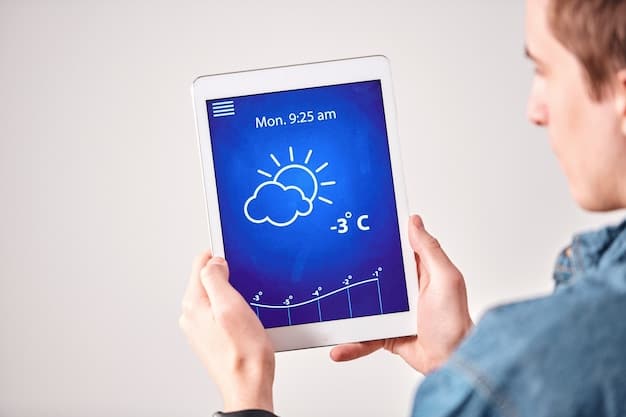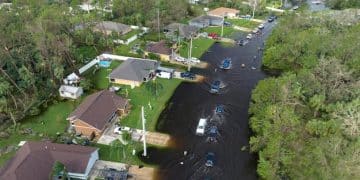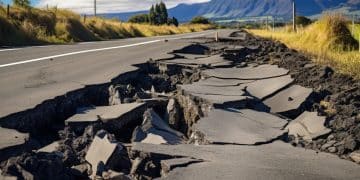Review Your Insurance Before Disaster Season: 5 Key Questions

Reviewing your insurance policy before disaster season in the US involves asking key questions about coverage types, limits, deductibles, exclusions, and claim procedures to ensure you’re adequately protected against potential losses from natural disasters.
Is your insurance policy truly ready for the upcoming disaster season in the US? Don’t wait until it’s too late; let’s explore crucial questions to fortify your protection now.
Reviewing Your Insurance Policy Before Disaster Season
Reviewing your insurance policy before the disaster season is a crucial step to ensure you are adequately protected against potential losses. Natural disasters can strike unexpectedly, and having the right coverage can make all the difference in recovering smoothly.
1. Understanding Your Coverage Types
Knowing the types of coverage you have is fundamental. Different policies cover different types of damage. Understanding what each policy covers will give you peace of mind going into the disaster season.
Homeowners Insurance
Most homeowners insurance policies cover damages from events like fire, wind, and hail. However, it’s essential to check if your policy includes specific endorsements for disasters common in your area.
Flood Insurance
Standard homeowners insurance typically doesn’t cover flood damage. If you live in an area prone to flooding, a separate flood insurance policy is essential. It covers damage caused by rising water due to heavy rains, hurricanes, or other weather events.
Earthquake Insurance
If you live in an area prone to earthquakes, earthquake insurance may be beneficial. This coverage helps pay to repair damage caused by seismic activity.

- Review Policy Inclusions: Check for specific disaster endorsements.
- Assess Flood Risk: Determine if flood insurance is necessary.
- Earthquake Prone Areas: Consider earthquake insurance if applicable.
Understanding these different types of coverage helps you prepare for various potential disasters. Make sure you have the right policies to match the risks in your area.
2. Assessing Coverage Limits
Coverage limits dictate the maximum amount your insurance company will pay for a covered loss. It’s vital to ensure these limits are adequate to cover potential damage and protect your investment.
Replacement Cost vs. Actual Cash Value
Determine whether your policy covers replacement cost or actual cash value. Replacement cost covers the cost to rebuild or repair your home with new materials, while actual cash value factors in depreciation.
Personal Property Coverage
Review the coverage limits for your personal property. Create an inventory of your belongings to estimate the value of your personal items. Decide if the limits are sufficient. Consider a floater or rider for high-value items.
Additional Living Expenses (ALE)
Additional living expenses cover costs such as hotel stays, meals, and other necessary expenses if you need to live elsewhere while your home is being repaired. Ensure that the coverage is adequate to maintain your lifestyle during displacement.
Assessing your coverage limits carefully helps prevent underinsurance, ensuring you have enough funds to recover fully from a disaster.
3. Understanding Deductibles
A deductible is the amount you pay out-of-pocket before your insurance coverage kicks in. Understanding your deductible is crucial as it influences your premium and your financial responsibility when a disaster strikes.

Standard vs. Percentage Deductibles
Some policies have a standard fixed deductible, while others use a percentage deductible based on your home’s insured value. A percentage deductible can lead to higher out-of-pocket expenses for major disasters.
Choosing the Right Deductible
Selecting the right deductible involves balancing your financial comfort and risk tolerance. A higher deductible typically means lower premiums but requires more cash on hand in case of a claim.
Reviewing Special Deductibles
Check for special deductibles for specific types of disasters. For instance, some policies may have a separate, higher deductible for hurricane or wind damage.
- Fixed vs. Percentage: Understand your deductible type.
- Financial Balance: Choose a deductible you can afford.
- Special Deductibles: Check for disaster-specific amounts.
Understanding your deductible helps manage your costs and prepares you for potential out-of-pocket expenses during a disaster.
4. Identifying Policy Exclusions
Policy exclusions are situations or types of damage that your insurance policy does not cover. Knowing these exclusions helps you understand the gaps in your coverage and consider additional protection.
Common Exclusions
Common exclusions can include damage from mold, pests, or wear and tear. Policies often exclude damage caused by acts of war, nuclear events, or intentional acts.
Water Damage
Be aware of the specific exclusions related to water damage. While flood insurance covers rising water, other types of water damage, such as sewer backups, may require additional endorsements or separate policies.
Business Operations
If you operate a business from your home, standard homeowners insurance may not cover business-related losses. Consider a separate business insurance policy for comprehensive coverage.
Identifying these exclusions enables you to make informed decisions about additional coverage or risk management strategies.
5. Understanding the Claims Process
Knowing how to file a claim and what to expect during the claims process is essential for a smooth experience after a disaster. Having a clear understanding can streamline your recovery.
Documenting the Damage
Take photos and videos of the damage as soon as it is safe to do so. Documenting the extent of the damage provides essential evidence for your insurance claim. Keep receipts for temporary repairs, such as boarding up windows.
Filing a Claim
File your claim as soon as possible after the event. Have your policy number and other relevant information ready. Understand the deadlines for filing a claim and any required documentation. If necessary, hire a public adjuster to assist with your claim.
Working with Adjusters
Insurance adjusters will assess the damage and determine the amount your insurance company will pay. Be prepared to provide them with all the necessary documentation. Understand your rights and obligations during the adjustment process. Verify the adjuster’s credentials and affiliations.
- Document Everything: Take photos and keep records.
- File Promptly: Submit your claim as soon as possible.
- Understand Assessments: Know your rights with adjusters.
Understanding the claims process helps to ensure a smooth and efficient experience, so you can focus on recovery after a disaster.
| Key Point | Brief Description |
|---|---|
| 💡 Coverage Types | Home, flood, earthquake insurance differences. |
| 💰 Coverage Limits | Replacement cost, personal property, and ALE. |
| 🧾 Deductibles | Fixed vs. percentage, disaster-specific amounts. |
| 🚫 Exclusions | Water damage, pests, business operations. |
Frequently Asked Questions
▼
Replacement cost covers the cost to rebuild or repair your home with new materials, while actual cash value factors in depreciation. Replacement cost provides better long-term financial security.
▼
No, standard homeowner’s insurance typically doesn’t cover flood damage. You need a separate flood insurance policy, especially if you live in a high-risk flood area.
▼
Take photos and videos of the damage as soon as it is safe. Document the extent of the damage. Keep receipts for any temporary repairs or necessary expenses you incur.
▼
Choosing the deductible involves balancing your financial comfort and risk tolerance. A higher deductible usually means lower premiums, but you’ll need to pay more out-of-pocket in a claim.
▼
Common exclusions include damage from mold, pests, or wear and tear. Policies often exclude damage caused by acts of war, nuclear events, and certain types of water damage, such as sewer backups.
Conclusion
Taking the time to review your insurance policy before disaster season is a proactive step that can protect your assets and ensure peace of mind. Understanding your coverage, limits, deductibles, exclusions, and claims process will enable you to navigate potential disasters with confidence and resilience.





